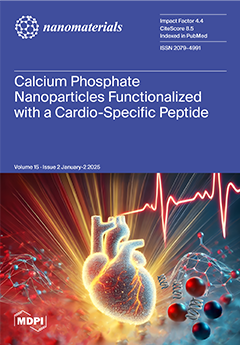Metal oxide semiconductor (MOS) hydrogen sensors offer advantages, such as high sensitivity and fast response, but their challenges remain in achieving low-cost fabrication and stable operation at room temperature. This study investigates Nb-doped TiO
2 (NTO) thin films prepared via a one-step micro-arc
[...] Read more.
Metal oxide semiconductor (MOS) hydrogen sensors offer advantages, such as high sensitivity and fast response, but their challenges remain in achieving low-cost fabrication and stable operation at room temperature. This study investigates Nb-doped TiO
2 (NTO) thin films prepared via a one-step micro-arc oxidation (MAO) with the addition of Nb
2O
5 nanoparticles into the electrolyte for room-temperature hydrogen sensing. The characterization results revealed that the incorporation of Nb
2O
5 altered the film’s morphology and phase composition, increasing the Nb content and forming a homogeneous composite thin film. Hydrogen sensing tests demonstrated that the NTO samples exhibited significantly improved sensitivity, selectivity, and stability compared to undoped TiO
2. Among the fabricated samples, NTO thin film prepared at Nb
2O
5 concentration of 6 g/L (NTO-6) showed the best performance, with a broad detection range, excellent sensitivity, rapid response, and good specificity to hydrogen. A strong linear relationship between response values and hydrogen concentration (10–1000 ppm) highlights its potential for precise hydrogen detection. The enhanced hydrogen sensing mechanism of NTO thin films primarily stems from the influence of Nb
2O
5; nanoparticles doping in the anatase-phase TiO
2 structure on the semiconductor surface depletion layer, as well as the improved charge transfer and additional adsorption sites provided by the Nb/Ti composite metal oxides, such as TiNb
2O
7 and Ti
0.95Nb
0.95O
4. This study demonstrates the potential of MAO-fabricated Nb-doped TiO
2 thin films as efficient and reliable hydrogen sensors operating at room temperature, offering a pathway for novel gas-sensing technologies to support clean energy applications.
Full article






